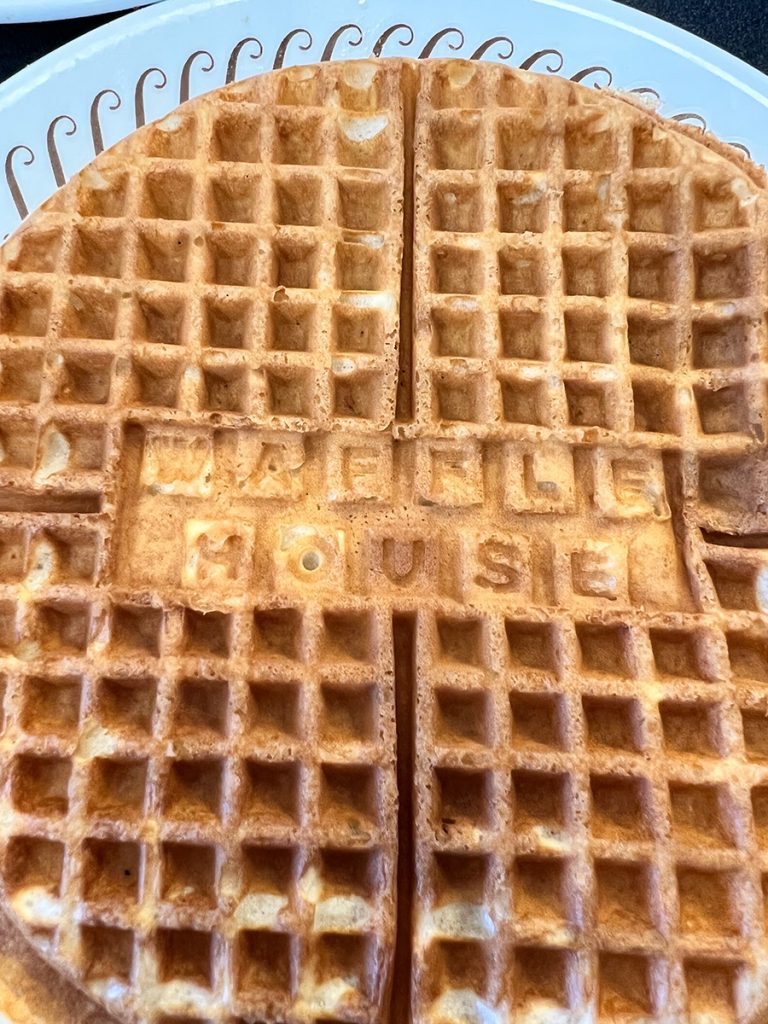
Reflections on Web 2.0 and social media from the franchise that time forgot

When you take your seat at a Waffle House counter you are likely to be greeted with a, “Hello honey, what can I get you?” Much nicer than an institutionally coached, “How may I help you?” as you approach the counter after standing in line.
I’m sitting at the counter of a Waffle House restaurant just outside of Charlotte, North Carolina, watching a double order of hash browns…“smothered” and “covered”…sizzling on the grill and destined for my plate. Above that grill is an unobtrusive placard that respectfully requests that firearms not be brought into the restaurant. I doubt that the décor has changed much—if at all—since the establishment opened. The walls are brown, wood-toned formica. The stainless steel grill and appliances look like they were designed in the 1950s. Ringing the ceiling are more small placards suggesting that I try Bert’s Chili or one of their other signature dishes. It looks pretty much like every other Waffle House I’ve ever visited, and there have been a few.
Okay, I admit it—I’m a Waffle House junkie despite my northern roots, and I actually plan my route around their online store locator when I travel south. If you’ve never experienced one of the more than 1500 Waffle House restaurants that dot Interstate highways across the American south and southwest, let’s just say that this could well be where the motto, “If it ain’t fried it ain’t food,” was first spoken. It’s also a franchise operation that gleefully ignores just about every rule or theory that marketers, franchising experts and other food chains hold as sacred. Yet it’s a franchise that has been successful ever since the first Waffle House opened in 1955—making it just as old as that other venerable franchise, McDonald’s.
But don’t think I’m trying to compare Waffle House to that 31,000-plus-unit, international behemoth. Beyond scale and revenues, a comparison simply wouldn’t be fair to Mickey-D. Ask those who have eaten at both and see if anyone’s willing to trade a fluffy Toddle House™ omelet for an Egg McMuffin™.
I would, however, contrast the Waffle House approach to fast (well, moderately fast) food with that of McDonald’s, or any other chain for that matter. There are lessons to be learned that may serve us well as our culture moves away from mass media and toward digitally supported social media.
Waffle House has become an icon despite lacking virtually every attribute of a modern franchise operation. They do not indulge in expensive national or regional advertising campaigns. Forget about clowns, kings or other mascots. There are no co-promotions with major motion pictures, no kid’s meals with plastic toys. There isn’t even a children’s menu. You won’t find a drive-thru window, an idiot-proof cash register with buttons for every possible order, an electronic order display in the kitchen or a microwave oven.
They do not see the wisdom of periodically updating things just to keep the franchise “fresh” for the customer. The décor is basic and seems to have changed little in over 50 years. They haven’t seen fit to refine or modernize their logo either—it’s still the same set of yellow squares, each bearing one letter of the Waffle House name. The menu—a two-sided plastic placemat—doesn’t appear to vary much either. And the low-quality menu product photos, which have never had the benefit of a food stylist, portray portions much smaller than what you will actually receive. If there’s a ”wrong” way to do something, they seem to have worked overtime in trying to achieve it.
Yet, they prosper.
Waffle House as Counter Culture (Pun Absolutely Intended)
What Waffle House does offer is a genuine experience instead of pre-packaged one. It’s an experience that involves real food served by people who actually seem pleased to be there. Contrast this with what you’ll find at any other national chain, where process stands in for personality and system is a substitute for substance. When you take your seat at a Waffle House counter you are likely to be greeted with a, “Hello honey, what can I get you?” Much nicer than an institutionally coached, “How may I help you?” as you approach the counter after standing in line. Your food is literally prepared in front of you, from fresh ingredients, and served with surprising speed. Not at Mc-speed, perhaps, but then cooking takes longer than reheating.
The Waffle House does have a few things other chains don’t, however, such as a discography—and I don’t mean a bunch of commercial jingles. I first discovered this at a Waffle House in Opelika, Alabama, that was equipped with a jukebox. Dozens of the available songs were about the Waffle House experience, including such classics as “Waffle House Thank You” by Mary Welch Rogers, and “844,739 Ways to Eat a Hamburger” by Billy Dee Cox (that’s really “having it your way” Burger King). There is also, apparently, a Waffle House museum in Decatur, Georgia, but I have to wonder what they could possibly have there that’s so old it isn’t still in the restaurants themselves.
So, why has this unconventional franchise thrived over time? Why do people write, record and apparently listen to songs about it? Word of mouth is the only answer, of course, along with providing a sincere experience and fresh, tasty food. And that brings me to the subject of today’s sermon.
Social Media Didn’t Begin With The Internet
We are at a technology-based watershed regarding the ways in which we communicate, and changes in communication invariably affect the ways in which we relate to each other and to our institutions. This has happened several times in human history…most notably with the invention of the printing press. Mass-produced books, pamphlets and newspapers facilitated the spread of ideas and opinions. It broke the monopoly over written communication that had been held for centuries by the clergy and nobility, and ultimately led to the diminishing power of both institutions. The last century saw new technologies, in the form of radio and then television, becoming increasingly influential while centralizing control, once again, in the hands of a relative few. Over the past two decades, the Internet has gradually been eroding that new monopoly, and today we are watching as it creates dramatic changes in our society.
Each new stage of communication develops its own grammar. Communication technologies that centralize tend to speak at you; those that decentralize invite discussion. In the mid-90s I made a presentation at a marketing association meeting that questioned whether the Internet would change our concept of branding, since it afforded consumers the ability to research and learn more about a given company or product than was previously available in a 30-second spot or a catchy slogan. The key to using the Internet, I surmised, seemed to involve building an advisory relationship with the consumer and achieving the position of a trusted source of information.
This was back when “Internet” meant websites, which were still somewhat centralizing in terms of content, if decentralized by the volume of sources available. Web 2.0, social media, new media…or whatever you wish to call it…is indeed a different animal. The grammar is one-to-one and personal; the dynamic is that of a village. It takes McLuhan’s “global village” a step further. Instead of sharing in common experiences, we can now participate in creating experiences. And as our individual, online identities become transportable between networking platforms, the viral effects will be magnified.
Mass Media vs. Mass Appeal
How this affects branding in the future is still the realm of guesswork, as those of us in marketing search for ways to bend the emerging dynamics to commercial purposes. It brings me back, however, to the Waffle House. Social media is the platform for digital word of mouth. Mass media attempt to prepare and convince us of what our experience of a product, service or company should be. Social media, on the other hand, lets us know what the actual experience has been for others. It isn’t a mass medium, it’s a medium of the masses.
For myself, I believe chances are good that tomorrow’s successful brands will be built more on delivering an experience that meets expectations than on trying to establish expectations that a particular product will be able to meet. Homogenized, one-size fits all service models will have to give way to ones that are more personal and individualized.
That is what I see in this North Carolina Waffle House. It doesn’t attempt to be all things to all people, or convince me that my experience will be more that it realistically can be. It is honest and it is sincere.
Here’s one more point of contrast that, perhaps, says it all. Visit the washroom of any chain restaurant and you will almost certainly find an elaborately designed tissue dispenser built to prevent people from stealing the roll. At this Waffle House, there is a simple iron bracket on the wall with two vertical, wooden dowels. Around each is a roll of toilet tissue, with absolutely nothing to prevent someone from removing it. It’s as though they’re saying, “Honey, if you need it that bad at home…”
Trust is a two-way street.
